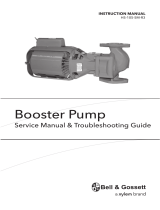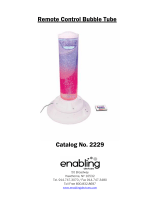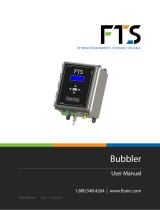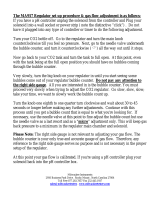Page is loading ...

H-3551T
OWNERS MANUAL
V3.0
D46 0814
GAS PURGE BUBBLER

This user manual is a guide for the H-3551T. For more information, updated manuals, brochures,
technical notes, and supporting software on the H-3551T
, please refer to
waterlog.com/3551 or contact your sales representative.
For additional assistance, please contact us at +1.435.753.2212 or [email protected]
CONTENTS & WARRANTY
WaterLOG® Warranty..........................................................1
Chapter 1: Introduction.......................................................2
3
Chapter 2: Getting Started.................................................4
5
Chapter 3: Installation........................................................ 6
7
7
8
Chapter 4: Setup & Operation........................................10
11
11
11
13
14
Chapter 5: Maintenance & Troubleshooting................15
17
Chapter 6: SDI-12 Command & Response Protocol...18
19
20
22
22
23
23
24
25
25-28
Chapter 7: Appendix..........................................................29
Bubbler Features.................................................................
What’s in the Box.................................................................
Product Description............................................................
Orifice & Sensor Connections...........................................
Recommended Field Installation Procedures.................
Maintenance Pressure Pump Procedures.......................
Purge Pump Failure...........................................................
Operation with H-350XL...................................................
Stand-alone Operation.....................................................
Manual Purge.....................................................................
Bubble Test.........................................................................
Command Summary.........................................................
Measure Command..........................................................
Concurrent Measure Command.....................................
Send Data Command.......................................................
Send Acknowledgement Command..............................
Initiate Verify Command...................................................
Send Identification Command........................................
Change Sensor Address Command..............................
Extended Commands.................................................

1
Contents & Warranty
“WATERLOG™ PRODUCTS MANUFACTURED BY YELLOW SPRINGS INSTRUMENTS CO., INC. are
warranted by Yellow Springs Instruments Co., Inc. (“YSI”) to be free from defects in materials and
workmanship under normal use and service for twelve (12) months from date of shipment unless
otherwise specified in the corresponding YSI pricelist or product manual.
WaterLOG™ products not manufactured, but that are re-sold by YSI, are warranted only to the
limits extended by the original manufacturer. Batteries, desiccant, and other consumables have
no warranty. YSI’s obligation under this warranty is limited to repairing or replacing (YSI’s option)
defective products,which shall be the sole and exclusive remedy under this warranty.
The customer shall assume all costs of removing, reinstalling, and shipping defective products to YSI.
YSI will return such products by surface carrier prepaid within the continental United States of America.
To all other locations, YSI will return such products best way CIP (Port of Entry) INCOTERM® 2010,
prepaid. This warranty shall not apply to any products which have been subjected to modification,
misuse, neglect, improper service, accidents of nature, or shipping damage. This warranty is in lieu
of all other warranties, expressed or implied. The warranty for installation services performed by YSI
such as programming to customer specifications, electrical connections to products manufactured by
YSI, and product specific training, is part of YSI’s product warranty. YSI EXPRESSLY DISCLAIMS AND
EXCLUDES ANY IMPLIED WARRANTIES OF MERCHANTABILITY OR FITNESS FOR A PARTICULAR
PURPOSE. YSI is not liable for any special, indirect, incidental, and/or consequential damages.”
A complete TERMS AND CONDITIONS OF SALE can be viewed at:
http://www.ysi.com/terms-and-conditions.php

INTRODUCTION
01 /
2

Introduction
3
The WaterLOG® H-3551T is a self-contained “smart” gas purge system which produces a precision, constant
mass flow of gas. Together with a pressure measurement device, it is used to measure fluid levels in applications
such as surface water (streams and lakes, etc.), ground water and tanks.
A sophisticated system of sensors and valves regulate the bubble rate and purge pressure. A battery operated
compressor and an internal microprocessor controller determines how much pressure is needed in the tank
based on the current head pressure, to produce a constant bubble rate. Hence, the term “smart”. The micro
controller also compensates for the effects of gas density change with temperature to maintain a constant
flow through the restriction. This portion of the H-3551T replaces the sight feed flow controller and pressure
regulator (Conflow system) used in previous systems.
The bubbler also provides a purge feature which temporarily pumps up the tank to a high pressure and opens
a valve to apply high pressure to the orifice line. This feature is designed to remove any sediment that may
have collected in or around the outlet of the orifice line.
The H-3551T is used primarily with the WaterLOG® H-350XL data logger, which performs several different
functions in the system. First, it is the precision pressure messurement source for measuring the fluid level. This
function replaces the manometer in previous systems. Second, it is the terminal through which the H-3551T
is configured. Third, it can be the data recorder for the system, thus removing the need for an external data
recorder.
Key Features:
• Provides a continuous gas ow
• Battery operated
• Microprocessor controlled
• One-piece manifold eliminates many potential sources of leaks
• Pressure gauge provides a visual indication of the tank pressure
• Hydrophobic intake membrane protects compressor
• All components are easily accessible for inspection and maintenance
• Compressor does not have a “diaphragm”
• Provides an internal pressure relief valve
• Compressor is designed and rated for cold temperature operation

GETTING STARTED
02 /
4

Getting Started
5
Before installation, setup and operation of the H-3551T in the field, read through this section for a general
overview of what you have and how to use it.
When unpacking your H-3551T, make sure all the components ordered are received and undamaged from
shipping. Some movement may have occured during shipping. It is recommended that you visually inspect
the inside of the enclosure to verify all electrical connections are secure. The basic package includes:
What’s in the Box
H-3551T Bubbler
CABLE ASSY,SDI,H-3551
CABLE ASSY, RS-485, H-3551 TO XL SERIES
H-355-INS-INSTALL KIT: (2) 1/8” NPT to 1/8” Tube Fittings,
(1) 1/8” NPT to 3/8” Tube Fittings, 6 ft. 1/8” Copper Tubing
Before installing the H-3551T you may wish to test the system in the shop or lab. This will familiarize you with
the instrument in an environment where it is easy to work and you are near a telephone if questions should
arise.
If you are unable to get the H-3551T up and running, refer to Chapter 3 (Installation) and Chapter 4 (Trouble
Shooting). If you have further questions, feel free to call one of our support personnel at +1.435.753.2212
option 2, for assistance.
Mounting Hardware

6
INSTALLATION
03 /

Installation
7
Installation instructions for the H-3551TTmay
vary depending on your specific application
and field conditions. It is important to
familiarize yourself with the connections
before installing a product at the site. Below
are standard connections found on the
H-3551T.
Atmospheric PSI Vent for Sensors
H-350XL Sensor Setup Port & Cable Connection
Compressor Air Intake Desiccator Connection
Constant Bubble Out Orifice Line Connection 1/8 inch FNPT
Enclosure Breather
Compressor Power (Connect First)
Power & Communications Main Interface Connection
In its simplest form, a gas purge pressure measurement system consists of a gas source, a pressure
measurement device and an orifice tube all connected together in a “T” arrangement. Because the H-3551T
has the capability of purging the orifice line, a more complex connection is required. Do not use a simple “T”
connection to connect the bubbler and pressure sensor to the orifice line, instead, use the two dedicated
ports of the H-3551T. The H-3551Tincludes an internal valve which isolates the pressure sensor output from
the orifice line during a purge sequence. This helps prevent a plugged orifice condition from damaging the
pressure sensor.
If you are using a pressure sensor other than the H-350XL, you may need to take extra precautions to further
protect your pressure sensor (see chapter 4).
Orifice and Sensor Connections

INSTALLATION
8
1. The H-3551Tmust be wall mounted in the vertical position, with the manifold down. Mounting feet are
provided. A vertical mount helps ensure moisture will not accumulate in the internal pressure tank.
2. Connect the pressure line between the H-3551T and your pressure measurement device. This can be
done using the H-3551T Install kit. This kit is designed for use with the H-350XL. If your measurement
device has different connections, you will need to provide the appropriate fittings. You will need a 1/8”
NPT male tubing fitting for the sensor output. It is recommended that you use the 1/8” copper tubing
supplied in the install kit. The proper ferrules must be used to insure there are no leaks.
3. The H-3551T requires two separate power sources. First is the compressor 12V which powers
the compressor and control valves. This supply is typically made with heavy gauge wire to the
gauge station 12V battery. Second is the 12V which powers the control module. This source is
supplied from the pressure measurement sensor through the interface cable (provided), and
into the control connector. It is best to connect the compressor power first, then the control
power second. If a pumping sequence fails, the controller suspends pumping for a while to allow
the battery to recharge. By connecting the pump power first, the controller will not prematurely
detect a dead battery and suspend pumping.
4. Generally, an external desiccator is required to dry the intake air. The desiccator prevents
accumulation of moisture in the tank, restriction and orifice line. Connect the output of the
desiccator to the port marked “intake”. Desiccators which employ “indicating” silica gel have the
advantage of visually showing the status of the desiccant. As the gel becomes saturated with
moisture, the gel turns blue. See Appendix-B for further information and the specification for a
recommended desiccator.
Recommended Field Installation Procedures
Pin No. Description Wire Color
1 RS485DAT+ Black
2 RS-485DAT- Brown
3 GND Red
4 GND Orange
5 +12V Yellow
6 +12V Green
7 +12V
8 SD-12 Data
9 Gnd
Table 3-1: H-3551T Control Connector
Figure 3-1: Installed Pressure Measurement System

Installation
9
Figure 3-2: Mounted on Plywood Panel
Please note the following:
1. The install kit provided connects the “Sensor”
out put port of the bubbler directly to the
“Pressure Input” of the H-350XL without any
additional parts.
2. The RS-485 serial cable provided is equipped
with plugs on both ends for direct connection
between the “control” input of the H-3551T and
the “Auxiliary output” of the H-350XL

OPERATION
04 /
10

11
Operation
During normal operation, if the tank pressure becomes too low the micro controller makes several tests
before turning the compressor on:
1. If the compressor power input (terminal strip) is below 10.0 volts, the compressor will not turn on. This is
to prevent further discharge of an already stressed battery.
2. The compressor will not turned on if a purge sequence within the previous elapsed 1-hour failed. This
allows the battery charger to charge the battery without the compressor draining the battery as fast
as it is charged. Once the compressor is turned on, the battery voltage is no longer monitored by the
microcontroller.
Maintenance Pressure Pump Failure
If the compressor runs longer than 60 seconds while pumping the tank to the pressure needed for the
desired bubble rate, the micro controller turns off the compressor and disables further pumping for
30-seconds.
Purge Pump Failure
When a purge sequence is initiated, the compressor is activated to pump the tank to the specified purge
pressure. If the compressor runs longer than 300 seconds while pumping the tank to the proper pressure,
the micro controller turns off the compressor and disables all further pumping for 1-hour.
While servicing the system, these battery protection features can be inadvertently activated if the 12V pump
power (via the terminal strip) is disconnected or fails while the compressor is running. You can recover from
these lockout conditions by momentarily disconnecting the RS-485 control connector to reset the micro
controller
Operation with the H-350XL
The following is a description of the H-350XL
submenus used for configuring the bubbler.
<Gas Purge Setup > Auto Purge Enbl[OFF]
Bubble Rate[XXX]/min
Purge Thresh[XXX]PSI
Purge Presur[XXX]PSI
Purge Time: [XXX]sec
Manual Purge: ENT=Y
Timed Prg: [XX] days
Tank PSI = XX.X
Diff PSI = XX.XX
LastPrg=MM/DD HH:MM

OPERATION
12
The H-350XL can sense when the orifice line is
restricted or plugged. The system can be configured
to do an automatic purge of the orifice line when it
becomes necessary. This menu item turns the auto
purge on or off.
<Gas Purge Setup > Auto Purge Enbl[OFF]
<Gas Purge Setup > Bubble Rate[XXX]/min
This setting specifies the bubble rate that should flow
from the end of the orifice tube. The programmable
range is 30 to 120 bubbles per minute.
<Gas Purge Setup > Purge Thresh[XXX]PSI
This setting sets the purge threshold. If the orifice line
pressure reaches the purge threshold, the H-350XL can
initiate an auto purge. The range of “Purge Thresh” is 10
to 65 psi.
<Gas Purge Setup > Purge Presur[XXX]PSI
This setting is the pressure that the H-3551T uses to
purge the orifice line. The range is 15 to 80 psi. Set
this value to a pressure which would reasonably purge
sediment and debris from the orifice. Keep in mind
that the higher pressures require more energy from the
battery.
<Gas Purge Setup > Purge Time: [XXX]sec
This setting is the duration of a purge in seconds. The
range is 30 to 240 seconds. Allow enough time for the
purge to dissipate and the bubble rate to fall near zero.
<Gas Purge Setup > Manual Purge: ENT=Y
Pressing <Enter> on this item will initiate a purge
sequence using the current purge settings.
<Gas Purge Setup > Timed Prg: [XX] days
This option is used to force a purge every XX days. The
limits are 00 to 99 days. If the option is set to 00 then
this option is in affect disabled. A value of 01 will cause
a purge every day. The purge will happen after the first
scan past noon.
<Gas Purge Setup > Tank PSI = XX.X
This value is the current pressure of the H-3551T’s
internal air tank in psi. This value is informative only
and cannot be edited. The tank pressure should be
approximately 3-5 PSI greater than the orifice pressure.

Operation
13
<Gas Purge Setup > Diff PSI = XX.XX
This value is the difference between the tank pressure
and the pressure on the orifice line in psi. Like tank
psi, this value cannot be edited. This value is directly
proportional to the bubble rate and should be
approximately 3-5 PSI.
<Gas Purge Setup > Last Prg=MM/DD HH:MM
This display shows the month, day any hour when the
last purge sequence was made.
If the auto-purge feature of the H-350XL is enabled, the H-350XL is responsible for initiating purges.
Whenever the H-350XL makes a measurement, it compares the pressure data with the “Purge Threshold”
value. If the pressure is greater than the Purge Threshold, the H-350XL commands the bubbler to initiate
a purge sequence. During the purge, the H-350XL energizes its internal auto-zero valve to isolate the
H-350XL's precision sensor from the purge pressure. At the completion of the purge, the H-350XL keeps its
auto-zero valve energized for an additional 2.0 seconds. This is done to prevent damage to the H-350XL's
precision sensor in case the orifice is plugged and the orifice line momentarily holds the full purge pressure.
A pressure relief valve in the bubbler vents the over pressure to atmosphere during the 2 second delay.
After completion of a purge sequence, the H-350XL makes another pressure measurement. If the pressure
is still greater than the Purge Threshold value, the H-350XL knows the purge failed. It then activates a timer
which disables further purges for the next 24 hours. This is done to prevent a plugged orifice form causing
continuous purges which would quickly drain the battery.
Stand-Alone Operation
The H-3551T gas purge system can be used “stand-alone” with pressure measurement devices other than
the H-350XL. You do lose some flexibility in that you cannot edit the bubbler settings in the field and the
purge feature cannot be coordinated with a pressure measurement such that pressure measurements are
not made during a purge.
When operating stand-alone, the factory preset values are:
Bubble Rate: 60 Bub/min
Pressure to Purge With: 40 PSI
Pressure to Initiate a Purge: 20 PSI
Purge Time: 45 sec
These settings can also be monitored or edited via the SDI-12 port built into the H-3551T The H-3551T
functions as a SDI-12 “sensor”. When connected to a SDI-12 host such as a data logger or H-4191 RS-232
side-kick interface you can issue extended SDI-12 commands to read or write these settings. If the data
logger issues and “aM!” command, the H-3551T initiates a purge sequence. See Chapter 5 for further
details.
If needed, these settings can be configured at the factory. The factory must be notified of desired settings
prior to shipment.

WARNING: THERE IS A DISTINCT POSSIBILITY OF DESTROYING YOUR PRESSURE SENSOR. THIS CAN BE
AVOIDED BY INSTALLING AN ISOLATION VALVE BETWEEN THE H-3551T AND YOUR SENSOR.
If a purge does not clear a plugged orifice line, the purge pressure will be applied to the sensor output
of the H-3551T. The H-350XL has an internal valve which protects its precision pressure transducer from
a failed purge. When operating the H-3551T with a sensor other than the H-350XL, the purge pressure
could be applied to your sensor before the H-3551T's internal pressure relief valve can pop. It is your
responsibility to verify that your sensor can handle the purge pressure, or install an isolation valve between
the H-3551T and your sensor. The valve must be closed prior to a purge and remain closed until the purge
is completed, or until the tank pressure falls below your sensor’s maximum pressure rating.
OPERATION
14
Manual Purge
The H-3551T has an internal button which allows a manual purge to be initiated. This feature allows you to
clear a plugged orifice or verify the orifice is clear. The Purge button is located inside the H-3551T enclosure,
on the top corner of the control module. Pressing this for one to two seconds initiates a purge sequence.
The compressor will be turned on and the tank pressure raised to the “Purge Pressure”. During this time,
the bubble rate will rise proportionally with the pressure. Next, the compressor is turned off and the purge
valve is actuated to dump the tank pressure directly to the orifice line. While the purge valve is actuated the
pressure sensor output is blocked by a valve to prevent the purge pressure from damaging the pressure
measurement system. During the purge, the orifice should produce vigorous bubbling with the bubble
rate falling eventually to zero. After a delay equal to the “Purge Delay”, the purge valve is closed and the
compressor is again turned on to restore the bubble rate to its normal value.
NOTE: When the button is pressed, if the tank pressure is already higher than the “Purge Pressure” the
purge sequence will not be initiated.

15
MAINTENANCE &
TROUBLE SHOOTING
05 /

16
MAINTENANCE & TROUBLE SHOOTING
Sustained operation of the H-3551Tis almost maintenance-free. Because the compressor only runs for a few
seconds every hour, it will last for many years. The H-3551Tincludes safety provisions that will not allow the
compressor to run continuously for long periods of time. This protects the pump and other components in
case of a plugged orifice or other malfunction.
Periodically check your gauge station battery to ensure it is in good condition for pumping together with
any other equipment that you have installed in the gauge station.
From time to time check the inlet line filter (located between the manifold and the suction side of the pump)
for any blockage or restriction. If blockage or restriction is present, the filter must be replaced.
All fittings must be secure. At 60 bubbles/minute, even a tiny leak will allow the entire gas flow to escape.
Maintenance
It is unlikely that this manual will ever contain trouble shooting tips to cover every problem that will be
encountered. Feedback from customers is very valuable and greatly aids in the quest for constant product
enhancement. Please feel free to call the factory for technical assistance and also with solutions you have
found to past problems.
The following list of problems and possible solutions.
H-350 reports “H-355 NOT RESPONDING”!
• Verify the power connections to the H-3551T. Reinitialize the internal controller by momentarily
unplugging the RS-485 control cable connector.
• Check all connections including Power, Gnd and the RS-485 communication connector. +12V power
must be supplied via both the compressor power terminals and the RS-485 connector (from the data
logger)
Intermittent Operation
• Check your power and ground connections. Moisture over time can oxidize and corrode the battery
terminals, connectors and pins.
• Measure the power supply/battery voltage at the input terminal strip while the pump is running.
• The H-3551T has several safety features which may suspend pumping in order to preserve a dead
battery. Refer to Chapter 2
Trouble Shooting

17
Maintenance & Trouble Shooting
When visiting a gauge station it is recommended to always take a bucket and a length of rubber tubing.
With the rubber tubing you can disconnect the station’s orifice line and direct the gas flow into a bucket
of water. This fast and productive test allows you to check for proper bubbling, leaks and other problems.
Realize however, if the H-3551T was bubbling into deep water, when you direct the gas flow to a shallow
bucket the bubble rate will be abnormally high for 5-10 minutes until the H-3551Tcan adjust to the new
water depth.
It is also recommended to have dish detergent, a small paintbrush or “snoop” in your toolbox for testing
for air leaks. Again, at 60 bubbles/minute, even a tiny leak will allow the entire gas flow to escape to the
atmosphere.
Bubble Test

SDI-12 COMMAND &
RESPONSE PROTOCOL
06 /
18
/



